Petroleum System Evaluation: Hydrocarbon Potential and Basin Dynamics in Abu Darag Sub-Basin, Northern Gulf of Suez (Egypt)
Abstract
1. Introduction
2. Geologic Setting
2.1. Pre-Rift Sequences (Cambrian to Oligocene)
2.1.1. Nubia Sandstone (Paleozoic to Early Cretaceous)
2.1.2. Mixed-Facies Sequence (Upper Cretaceous)
2.2. Syn-Rift Sequences
2.2.1. Nukhul Formation (Aquitanian)
2.2.2. Rudeis Formation (Langhian–Burdigalian)
2.2.3. Kareem Formation (Langhian-Serravallian)
2.2.4. Belayim Formation (Serravallian)
2.3. Post-Rift Sequences (Pliocene-Recent)
3. Materials and Methods
4. Results
4.1. Source Rock Evaluation
4.2. Reservoir Petrophysics
4.3. Basin Modeling
4.3.1. Boundary Conditions and Model Calibration
4.3.2. Sedimentation and Subsidence Rate
4.3.3. Burial History Modeling and Hydrocarbon Generation
4.3.4. Maturity Mapping
4.4. Peroleum System of Abu Darag Sub-Basin
5. Discussion
6. Conclusions
- The present study concludes that the Gulf of Suez’s Miocene and Paleozoic sandstone formations offer a significant resource for hydrocarbon exploration and extraction. The mature, well-sorted sandstones contain reservoirs with up to 60% recovery factors, good permeabilities of about 400 mD, and porosity values of up to 29%.
- The Nukhul Formation shows a titled fault block bound by two major normal faults trending WNW-ESE.
- The petrophysical analysis in the North Darag-1 well calculated 126 ft average net pay (NEP), 19% average shale volume (Vsh), 17% average effective porosity (PHIE), and 57% average water saturation (SW). Sedimentation rate models of the GS-24-1 well showed two sequences. The first sequence shows that the rate of deposition increased during the Cenomanian when the marine shales of the Raha Formation were deposited. The second sequence was initiated in the Early Miocene when rifting started along with the deposition of shales and sandstones of the Lower Rudeis Member.
- The burial history model shows gradual subsidence and deposition in the Abu Darag sub-basin from the Paleozoic until the Early Cretaceous. By the end of Early Cretaceous, the basin was subjected to a major compression and uplift followed by erosion. In the extreme northern GOS, the effects of the Syrian Arc System have led to the absence of Upper Cretaceous–Paleocene deposits. This was followed by subsidence during the Early Eocene epoch and subsequently, the area underwent uplift during the Oligocene, which occurred during the syn-rift phase. Throughout the Miocene, rifting persisted, resulting in the deposition of the Rudeis, Kareem, and Nukhul formations. The Belayim, South Gharib, and Zeit evaporites were eroded before the end of the Miocene due to uplift which is considered as the main risk for hydrocarbon accumulation. The early oil generation took place in the Early Cretaceous, and the early oil window is 4000 ft deep. The Early Miocene saw the most oil generation, and this window of time was 7400 ft deep. In the research region, only the Nubia-A Lower Member (Late Triassic–Late Jurassic) has been shown to be a viable source rock capable of producing hydrocarbons.
- The modeled vitrinite reflectance map of Nubia-A Lower Member indicates that most of the area is located within the main oil window (Ro% 0.75%–1.0%) at a depth > 5000 ft. The maturity of the Jurassic Nubia-A Lower Member increases toward the GS-24-1 well and decreases toward the northwest and southeast. The northwestern part is inactive (TR < 10%), while hydrocarbon generation increases to the middle of the Abu Darag sub-basin where TR is >60%. The geologic traps formed during the Late Cretaceous and Miocene rifting phase and were later charged by hydrocarbons through migration and accumulation in the Late Oligocene.
Author Contributions
Funding
Data Availability Statement
Acknowledgments
Conflicts of Interest
References
- Said, R. The Geology of Egypt; Balkema: Rotterdam, The Netherland; Brookfield, WI, USA, 1990; p. 734. [Google Scholar]
- Shahin, A.N.; Hassouba, A.H.; Sharaf, L.M. Assessment of Petroleum Potential in the Northern Gulf of Suez. In Proceedings of the 12th Petroleum Exploration and Production Conference, Cairo, Egypt, 12–15 November 1994; Part I of II; pp. 152–174. [Google Scholar]
- Azab, A.A.; El-Khafeef, A.A. Fault Blocks of Abu Darag Basin, Northern Gulf of Suez, Egypt, as Deduced from Potential Field Data Interpretation. Discov. J. 2014, 25, 11. [Google Scholar]
- Shahin, A.N. Oil Window in the Gulf of Suez Basin, Egypt. AAPG Bulletin; American Association of Petroleum Geologists: Tulsa, OK, USA, 1 August 1988; p. 72. [Google Scholar]
- El-Gendy, N.; Barakat, M.; Abdallah, H. Reservoir Assessment of the Nubian Sandstone Reservoir in South Central Gulf of Suez, Egypt. J. Afr. Earth Sci. 2017, 129, 596–609. [Google Scholar] [CrossRef]
- Abdullah, E.A.; Al-Areeq, N.M.; Al-Masgari, A.; Barakat, M.K. Petrophysical Evaluation of the Upper Qishn Clastic Reservoir in Sharyoof Oil Field, Sayun-Masilah Basin, Yemen. ARPN J. Eng. Appl. Sci. 2021, 16, 2375–2394. [Google Scholar]
- Abdelwahab, F.M.; El Gendy, N.H.; Barakat, M.K.; Mohamed, M.S.; El-Tohamy, A.M.; El Terb, R.A.; El Feky, M.G. Radionuclide Content and Radiation Dose Rates of Uraniferous and Mineralized Granites at GV Occurrence in Gabal Gattar, Northeastern Desert, Egypt. Proc. J. Phys. Conf. Ser. 2022, 2305, 012006. [Google Scholar] [CrossRef]
- Azab, A.A.; Nabawy, B.S.; Mogren, S.; Saqr, K.; Ibrahim, E.; Qadri, S.T.; Barakat, M.K. Structural Assessment and Petrophysical Evaluation of the Pre-Cenomanian Nubian Sandstone in the October Oil Field, Central Gulf of Suez, Egypt. J. Afr. Earth Sci. 2024, 218, 105351. [Google Scholar] [CrossRef]
- Tissot, B.P.; Welte, D.H. Petroleum Formation and Occurrence; Springer: Berlin/Heidelberg, Germany, 2013. [Google Scholar]
- Espitalie, J.; Deroo, G.; Marquis, F. Rock-Eval Pyrolysis and Its Applications. Rev. De L Inst. Fr. Du Pet. 1985, 40, 563–579. [Google Scholar] [CrossRef]
- Welte, D.H.; Horsfield, B.; Baker, D.R. Petroleum and Basin Evolution; Springer: Berlin/Heidelberg, Germany, 1997; Volume 535. [Google Scholar]
- Waples, D.W. Geochemistry in Petroleum Exploration; Springer: Berlin/Heidelberg, Germany, 2013. [Google Scholar]
- Schlumberger Well Evaluation Conference, Cairo, Egypt; Schlumberger Middle East Surface: Abu Dubai, United Arab Emirates, 1984; Chapter 1; pp. 1–64.
- Schlumberger Well Evaluation Conference, Cairo, Egypt; Technical Editing Services, Ltd.: Chester, UK, 1995; p. 87.
- Bosworth, W.; Tari, G. Hydrocarbon Accumulation in Basins with Multiple Phases of Extension and Inversion: Examples from the Western Desert (Egypt) and the Western Black Sea. Solid Earth Discuss 2020, 2020, 1–31. [Google Scholar] [CrossRef]
- Moustafa, A.R.; Khalil, S.M. Structural Setting and Tectonic Evolution of the Gulf of Suez, NW Red Sea and Gulf of Aqaba Rift Systems. In The Geology of Egypt; Hamimi, Z., El-Barkooky, A., Martínez Frías, J., Fritz, H., Abd El-Rahman, Y., Eds.; Regional Geology Reviews; Springer International Publishing: Cham, Switzerland, 2020; pp. 295–342. ISBN 978-3-030-15264-2. [Google Scholar]
- Ghorab, M.A. Abnormal Stratigraphic Features in Ras Gharib Oilfield; Dar El-Kitab: Casablanca, Morocco, 1961. [Google Scholar]
- Farouk, S.; Sen, S.; Saada, S.A.; Eldosouky, A.M.; Elsayed, R.; Kassem, A.A.; Al-Kahtany, K.; Abdeldaim, A. Characterization of Upper Cretaceous Matulla and Wata Clastic Reservoirs from October Field, Central Gulf of Suez, Egypt. Geomech. Geophys. Geo-Energ. Geo-Resour. 2023, 9, 106. [Google Scholar] [CrossRef]
- Hantar, G. Remarks on the Distribution of Miocene Sediments in the Gulf of Suez Region. In Proceedings of the 5th Arabian Petroleum Congress, Cairo, Egypt, 16–23 March 1965; Cairo University: Cairo, Egypt, 1965; pp. 1–13. [Google Scholar]
- Garfunkel, Z. The Tectonics of the Suez Rift. Geol. Surv. Isr. Bull. 1977, 71, 1–44. [Google Scholar]
- Abu Shama, A.; El-Nahrawy, S.; Farouk, S.; Jovane, L.; Al-Kahtany, K.; Zaky, A.S. Calcareous Nannofossil Biostratigraphy, Bioevents, and Palaeoecological Interpretation of the Lower-Middle Miocene Outcrops in West Central Sinai (Egypt). Front. Earth Sci. 2024, 12, 1442241. [Google Scholar] [CrossRef]
- Evans, A.L. Miocene Sandstone Provenance Relations in the Gulf of Suez: Insights into Synrift Unroofing and Uplift History. AAPG Bull. 1990, 74, 1386–1400. [Google Scholar]
- Moustafa, A.R. Geologic Maps of the Eastern Side of the Suez Rift (Western Sinai Peninsula), Egypt. AAPG Map Ser. Scale 2004, 1, 9. [Google Scholar]
- Awney, F.; Hussein, R.; Nakhla, A. Blayim Marine and Land Oil Fields Structural Styles. In Proceedings of the Tenth EGPC Petroleum Exploration and Production Conference, Cairo, Egypt, 17–20 November 1990; Volume 1, pp. 400–430. [Google Scholar]
- Lafargue, E.; Marquis, F.; Pillot, D. Rock-Eval 6 Applications in Hydrocarbon Exploration, Production, and Soil Contamination Studies. Rev. L’institut Français Pétrole 1998, 53, 421–437. [Google Scholar] [CrossRef]
- Behar, F.; Beaumont, V.; Penteado, H.D.B. Rock-Eval 6 Technology: Performances and Developments. Oil Gas Sci. Technol. 2001, 56, 111–134. [Google Scholar] [CrossRef]
- ISO 7404-2; Methods for the Petrographic Analysis of Coals. ISO: Geneva, Switzerland, 2009.
- ASTM D7708-14; Standard Test Method for Microscopical Determination of the Reflectance of Vitrinite Dispersed in Sedimentary Rocks. ASTM International: West Conshohocken, PA, USA, 2014. [CrossRef]
- GUPCO GS-24-1; Final Well Report Well (Internal Report). Gulf of Suez Petroleum Company: Cairo, Egypt, 1977.
- Dow, W.G. Kerogen Studies and Geological Interpretations. J. Geochem. Explor. 1977, 7, 79–99. [Google Scholar] [CrossRef]
- Allen, A.P.; Allen, R.J. Basin Analysis: Principles and Applications, 2nd ed.; Blackwell Scientific Publications: Oxford, UK, 2005. [Google Scholar]
- Farouk, S.; Sen, S.; Belal, N.; Omran, M.A.; Assal, E.M.; Sarhan, M.A. Assessment of the Petrophysical Properties and Hydrocarbon Potential of the Lower Miocene Nukhul Formation in the Abu Rudeis-Sidri Field, Gulf of Suez Basin, Egypt. Geomech. Geophys. Geo-Energ. Geo-Resour. 2023, 9, 36. [Google Scholar] [CrossRef]
- Rider, M.H. The Geological Interpretation of Well Logs; Blackie: Glasgow, Scotland, 1986. [Google Scholar]
- Peters, K.E. Guidelines for Evaluating Petroleum Source Rock Using Programmed Pyrolysis. AAPG Bull. 1986, 70, 318–329. [Google Scholar]
- Peters, K.E.; Cassa, M.R. Applied Source Rock Geochemistry: Chapter 5: Part II. Essential Elements; AAPG: Tulsa, OK, USA, 1994. [Google Scholar]
- Jarvie, D.M.; Morelos, A.; Han, Z. Detection of Pay Zones and Pay Quality, Gulf of Mexico: Application of Geochemical Techniques; AAPG: Tulsa, OK, USA, 2001. [Google Scholar]
- Delvaux, D.; Martin, H.; Leplat, P.; Paulet, J. Geochemical Characterization of Sedimentary Organic Matter by Means of Pyrolysis Kinetic Parameters. Org. Geochem. 1990, 16, 175–187. [Google Scholar] [CrossRef]
- Vandenbroucke, M.; Largeau, C. Kerogen Origin, Evolution and Structure. Org. Geochem. 2007, 38, 719–833. [Google Scholar] [CrossRef]
- Vega-Ortiz, C.; Beti, D.R.; Setoyama, E.; McLennan, J.D.; Ring, T.A.; Levey, R.; Martínez-Romero, N. Source Rock Evaluation in the Central-Western Flank of the Tampico Misantla Basin, Mexico. J. South Am. Earth Sci. 2020, 100, 102552. [Google Scholar] [CrossRef]
- Amoako, K.; Zhong, N.; Osei-Boakye, N.P.; Apesegah, E. The Organic Geochemistry of Crude Oil in the Saltpond Basin (Ghana): Organic Source Input, Depositional Environment, and Thermal Maturity. Acta. Geochim. 2024, 43, 424–440. [Google Scholar] [CrossRef]
- Alsharhan, A.S. Petroleum Geology and Potential Hydrocarbon Plays in the Gulf of Suez Rift Basin, Egypt. AAPG Bull. 2003, 87, 143–180. [Google Scholar]
- Khaled, K.A.; Attia, G.M.; Metwalli, F.I.; Fagelnour, M.S. Subsurface Geology and Petroleum System in the Eastern Offshore Area, Nile Delta, Egypt. J. Appl. Sci. Res. 2014, 10, 254–270. [Google Scholar]
- Suggate, R.P. Relations between depth of burial, vitrinite reflectance and geothermal gradient. J. Pet. Geol. 1998, 21, 5–32. [Google Scholar] [CrossRef]
- Ahmed, M.A.A. Geodynamic Evolution and Petroleum System of Abu Gharadig Basin, North Western Desert, Egypt. Ph.D. Thesis, RWTH Aachen University, Aachen, Germany, 2008. [Google Scholar]
- Elmaadawy, K.G. Thermal Maturity Modelling for the Pre-Miocene Source Rocks in Ras Garra Area, Suez Rift Basin, Egypt. J. Afr. Earth Sci. 2020, 163, 103746. [Google Scholar] [CrossRef]
- Wygrala, B.P. Integrated Study of an Oil Field in the Southern Po Basin, Northern Italy. Ph.D. Thesis, University of Cologne, Cologne, Germany, 1989. [Google Scholar]
- Steckler, M.S.; Feinstein, S.; Kohn, B.P.; Lavier, L.L.; Eyal, M. Pattern of Mantle Thinning from Subsidence and Heat Flow Measurements in the Gulf of Suez: Evidence for the Rotation of Sinai and Along-strike Flow from the Red Sea. Tectonics 1998, 17, 903–920. [Google Scholar] [CrossRef]
- Pollack, H.N.; Hurter, S.J.; Johnson, J.R. Heat Flow from the Earth’s Interior: Analysis of the Global Data Set. Rev. Geophys. 1993, 31, 267–280. [Google Scholar] [CrossRef]
- Fagelnour, M.; Gamil, I.; El Toukhy, M.; Gharieb, A.; Saad, H. Source Rock Potentiality, Basin Modeling, and Oil to Source Correlation in Northern Shushan Basin, Western Desert, Egypt. In Proceedings of the Offshore Mediterranean Conference and Exhibition, Ravenna, Italy, 27–29 March 2019; OMC: Ravenna, Italy, 2019. [Google Scholar]
- Farouk, S.; Arafat, M.; Fagelnour, M.S.; Al-Kahtany, K.; Gentzis, T. Petroleum System Assessment of the Beni Suef Basin, Western Desert, Egypt. J. Afr. Earth Sci. 2024, 217, 105345. [Google Scholar] [CrossRef]
- Allen, A.P.; Allen, R.J. Basin Analysis: Principles and Applications, 1st ed.; Blackwell Scientific Publications: Oxford, UK, 1990. [Google Scholar]
- Sweeney, J.J.; Burnham, A.K. Evaluation of a Simple Model of Vitrinite Reflectance Based on Chemical Kinetics. AAPG Bull. 1990, 74, 1559–1570. [Google Scholar]
- Pepper, A.S.; Corvi, P.J. Simple Kinetic Models of Petroleum Formation. Part I: Oil and Gas Generation from Kerogen. Mar. Pet. Geol. 1995, 12, 291–319. [Google Scholar] [CrossRef]
- Moretti, I.; Kerdraon, Y.; Rodrigo, G.; Huerta, F.; Griso, J.J.; Sami, M.; Said, M.; Ali, H. South Alamein Petroleum System (Western Desert, Egypt). Pet. Geosci. 2010, 16, 121–132. [Google Scholar] [CrossRef]
- Walters, C.C. The Origin of Petroleum. In Practical Advances in Petroleum Processing; Hsu, C.S., Robinson, P.R., Eds.; Springer: New York, NY, 2006; pp. 79–101. ISBN 978-0-387-25811-9. [Google Scholar]


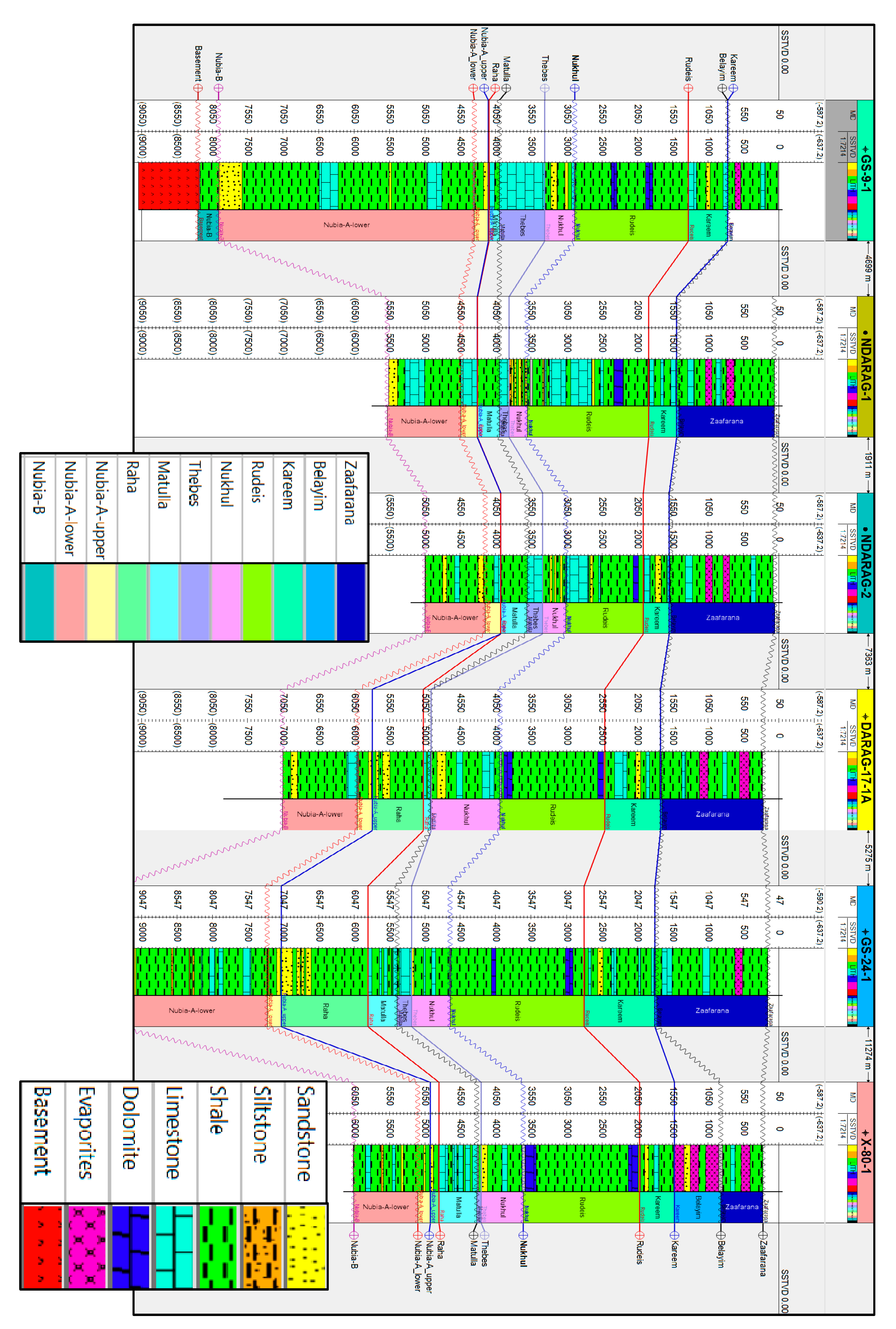
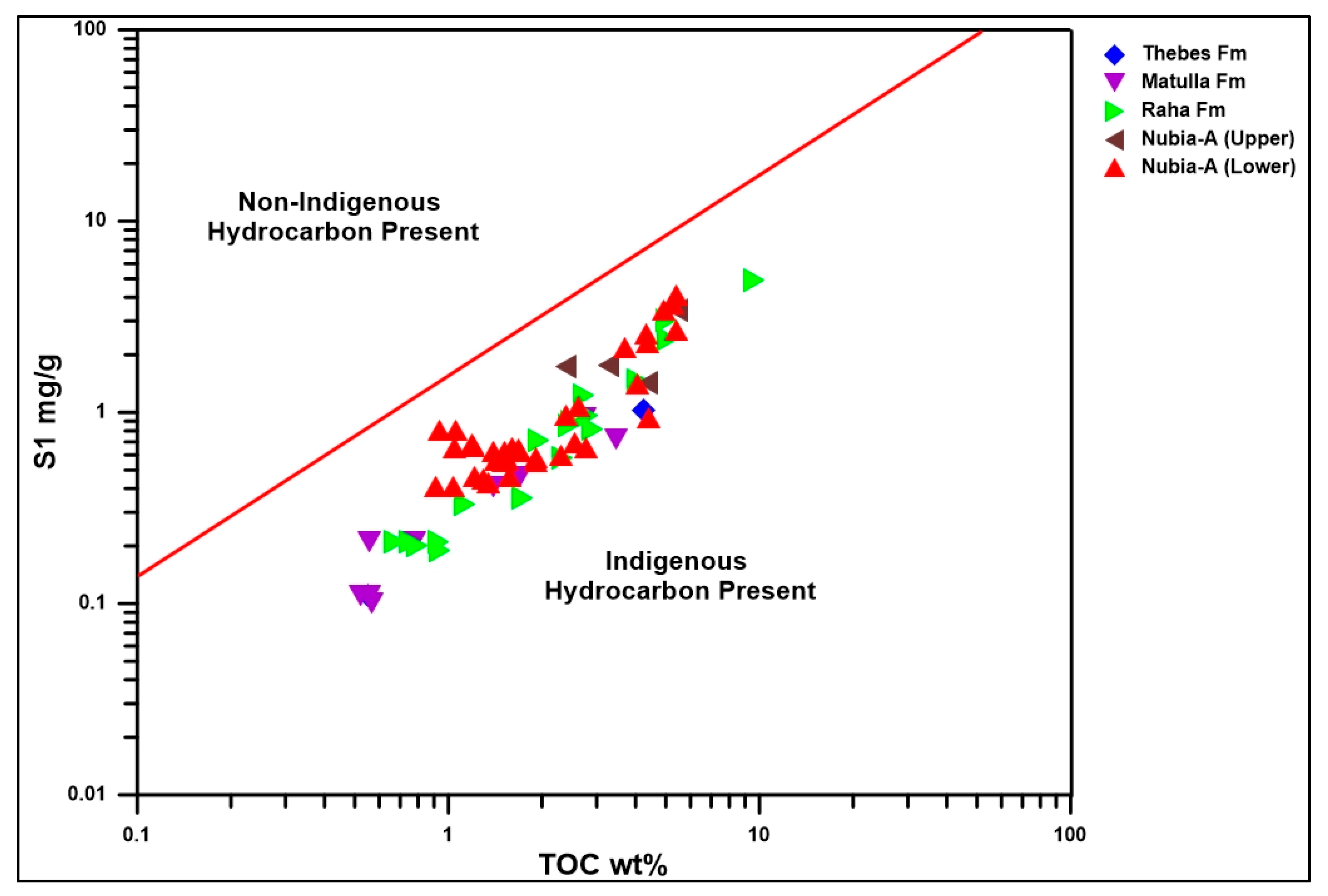

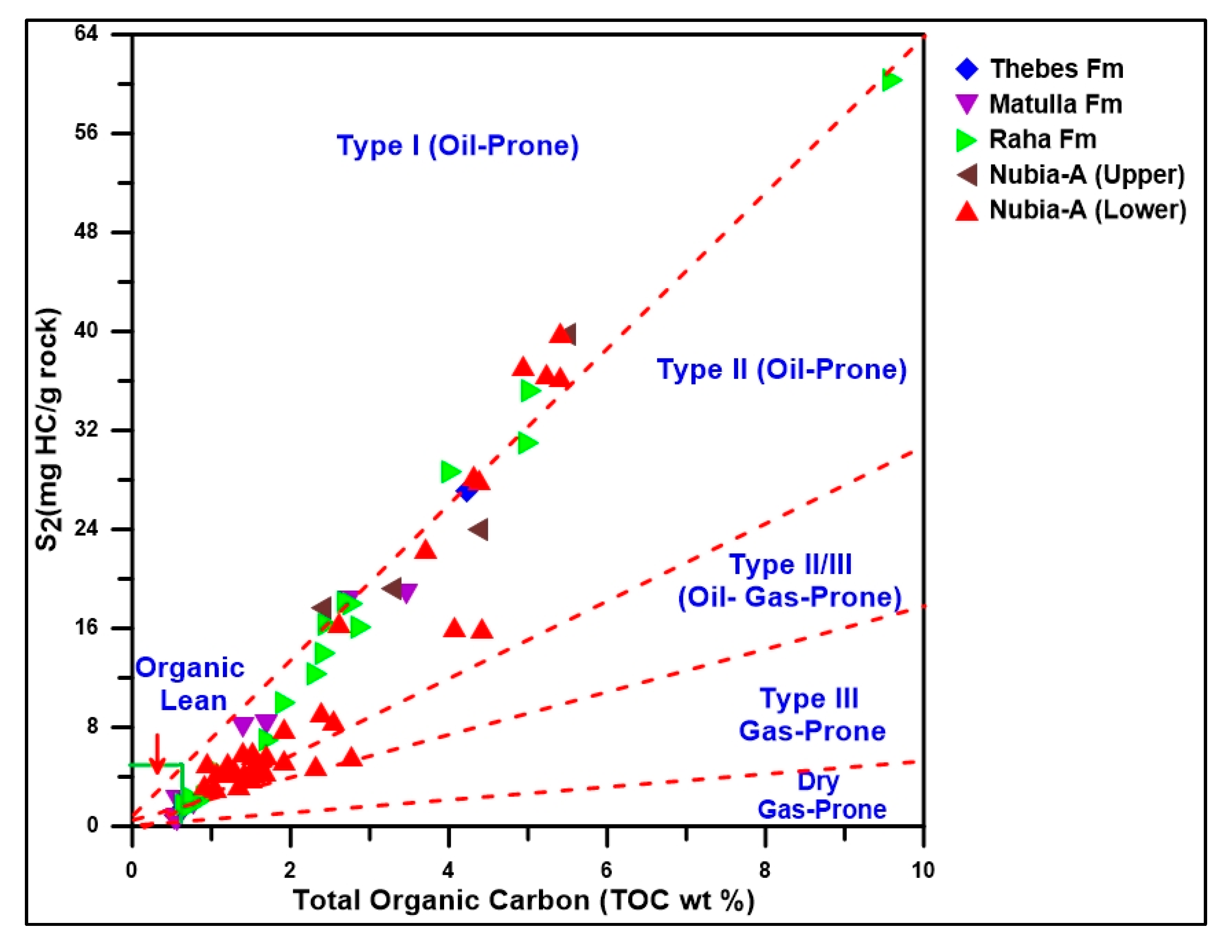
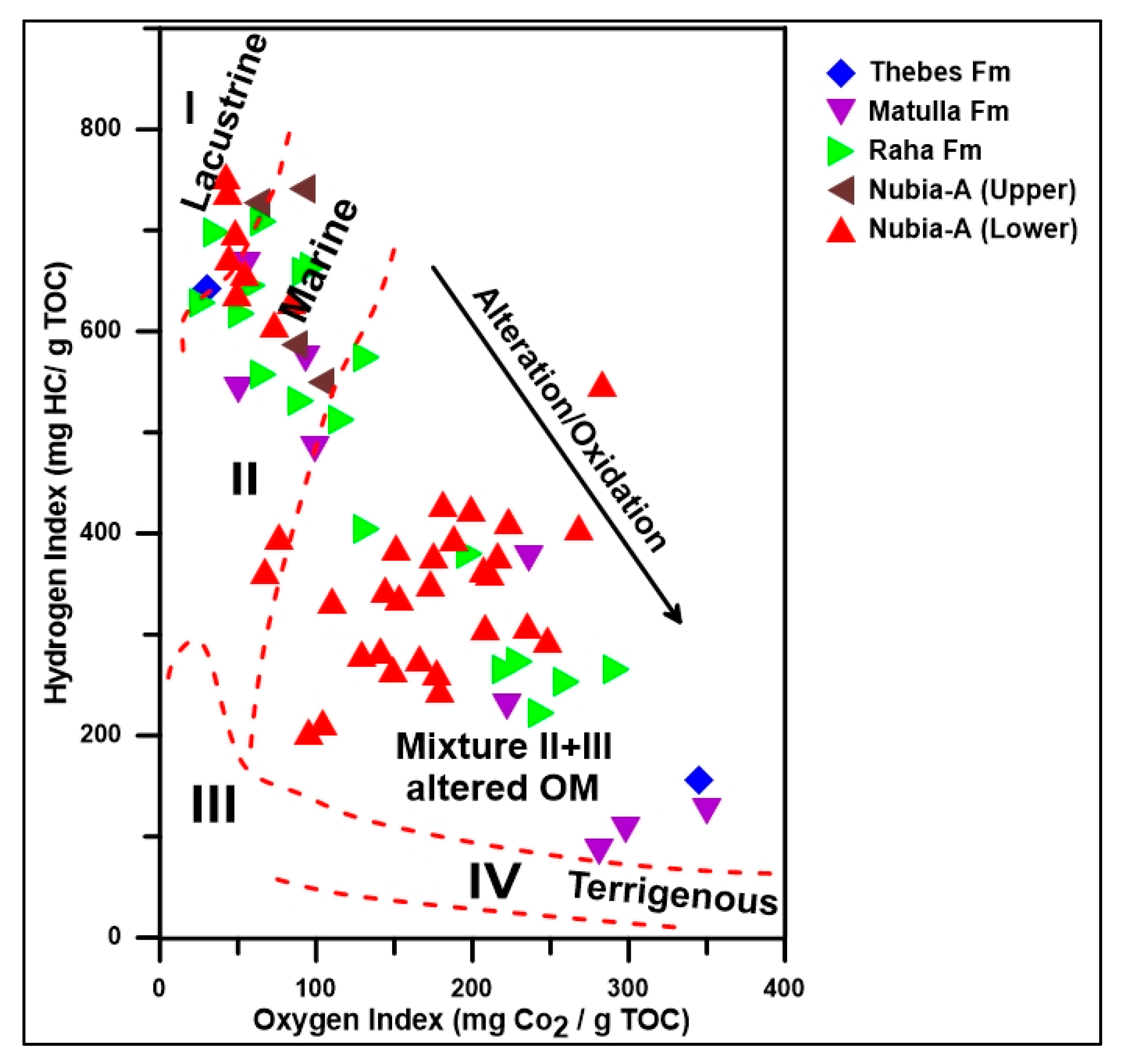

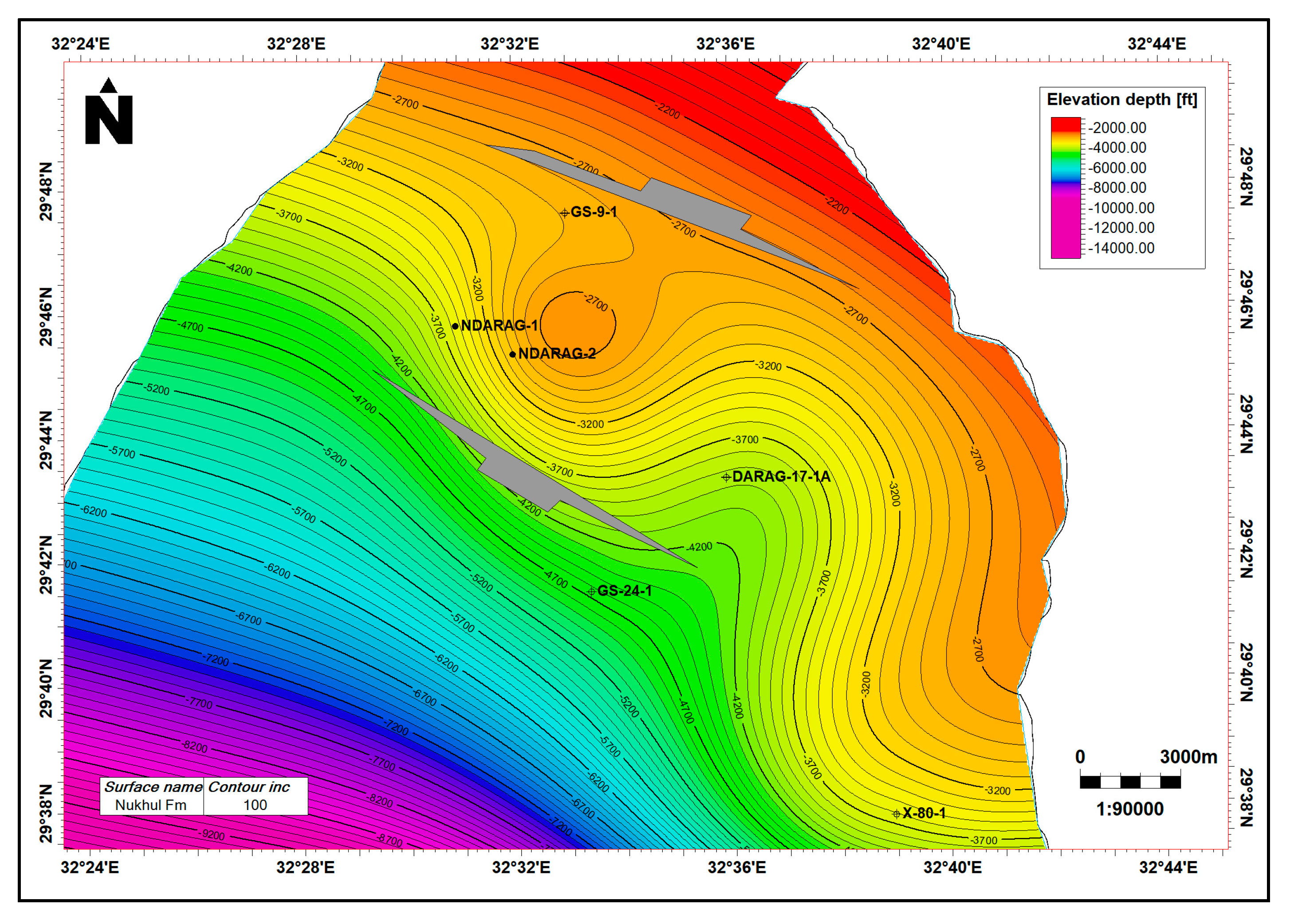
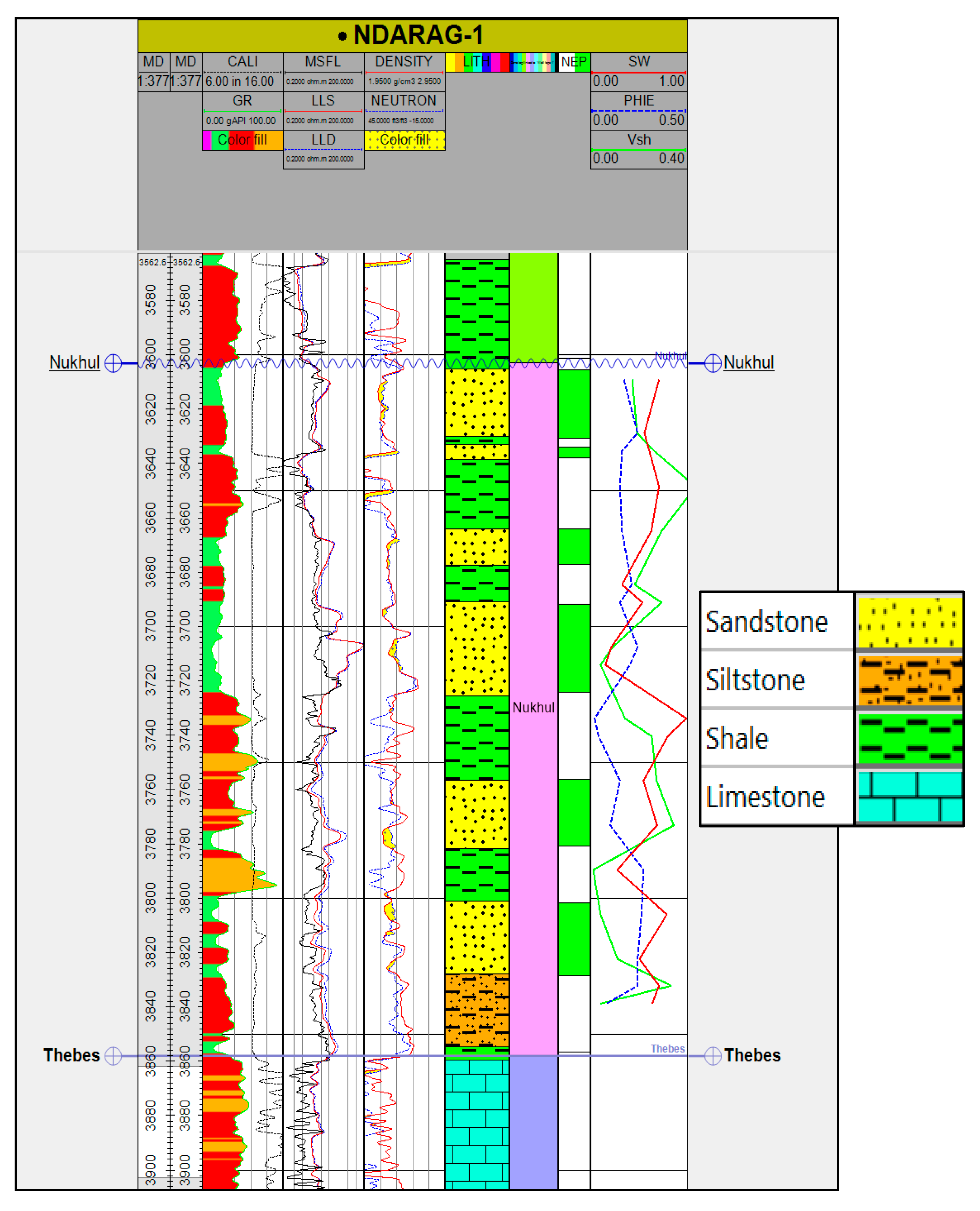

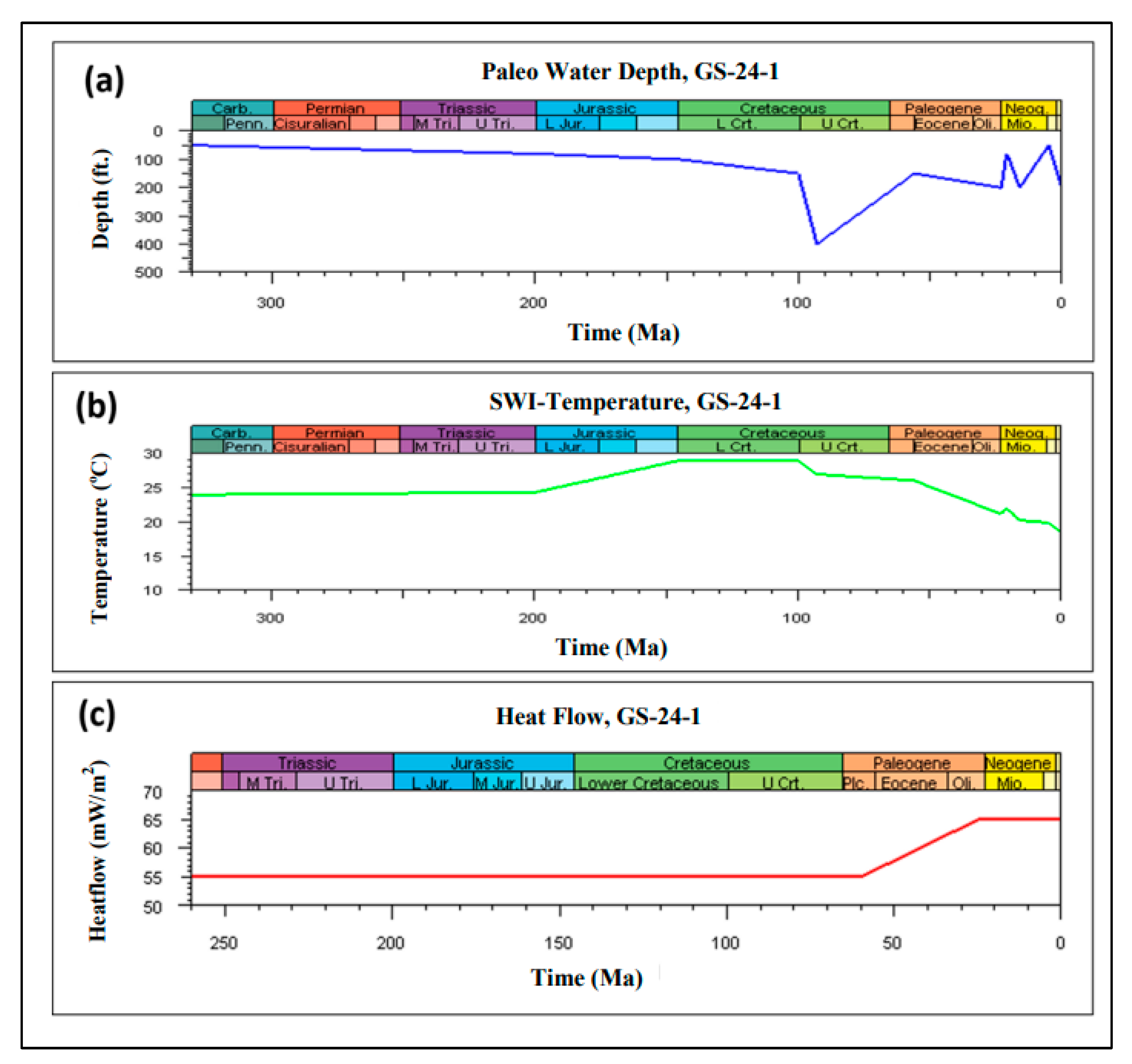


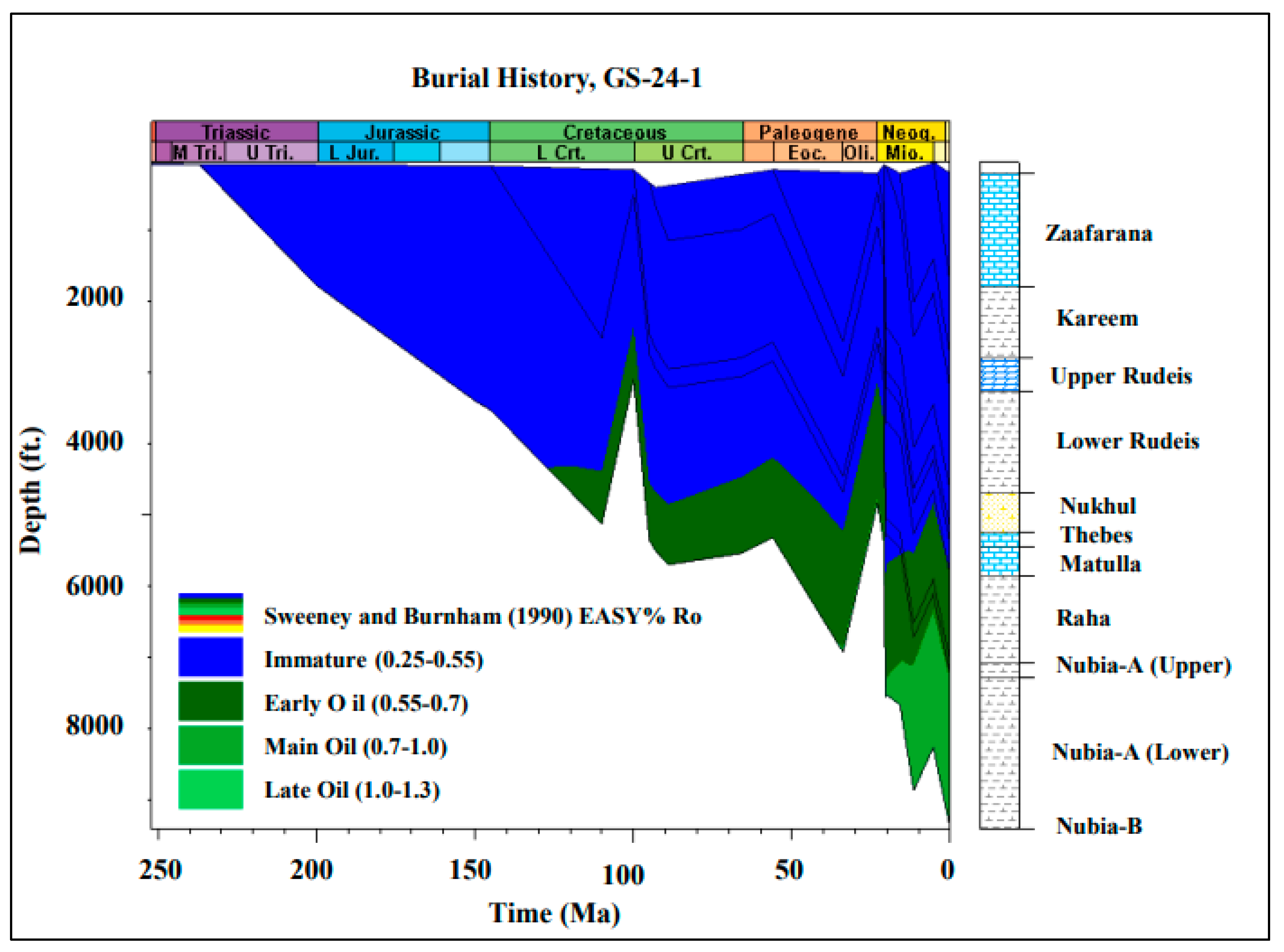
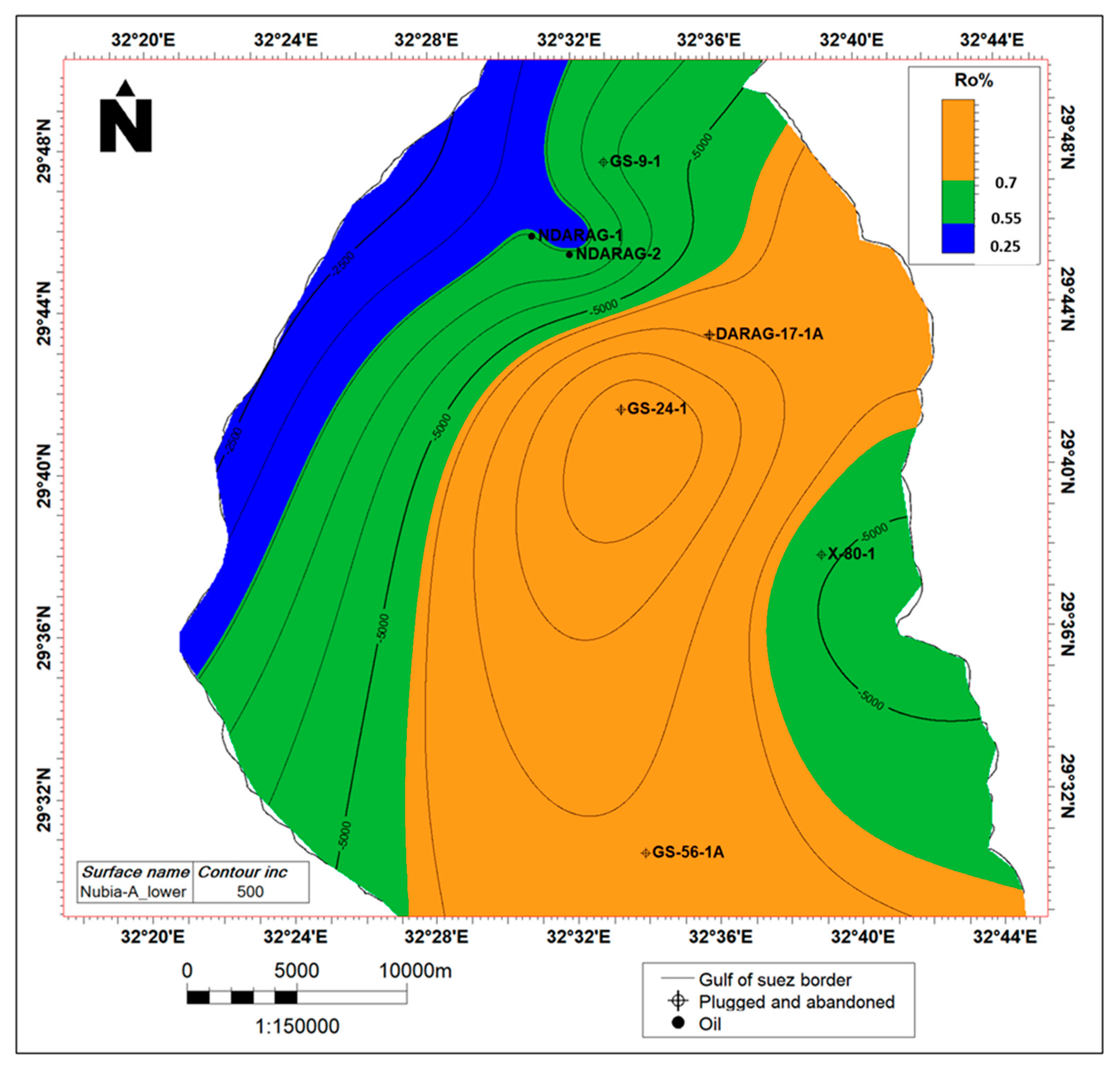

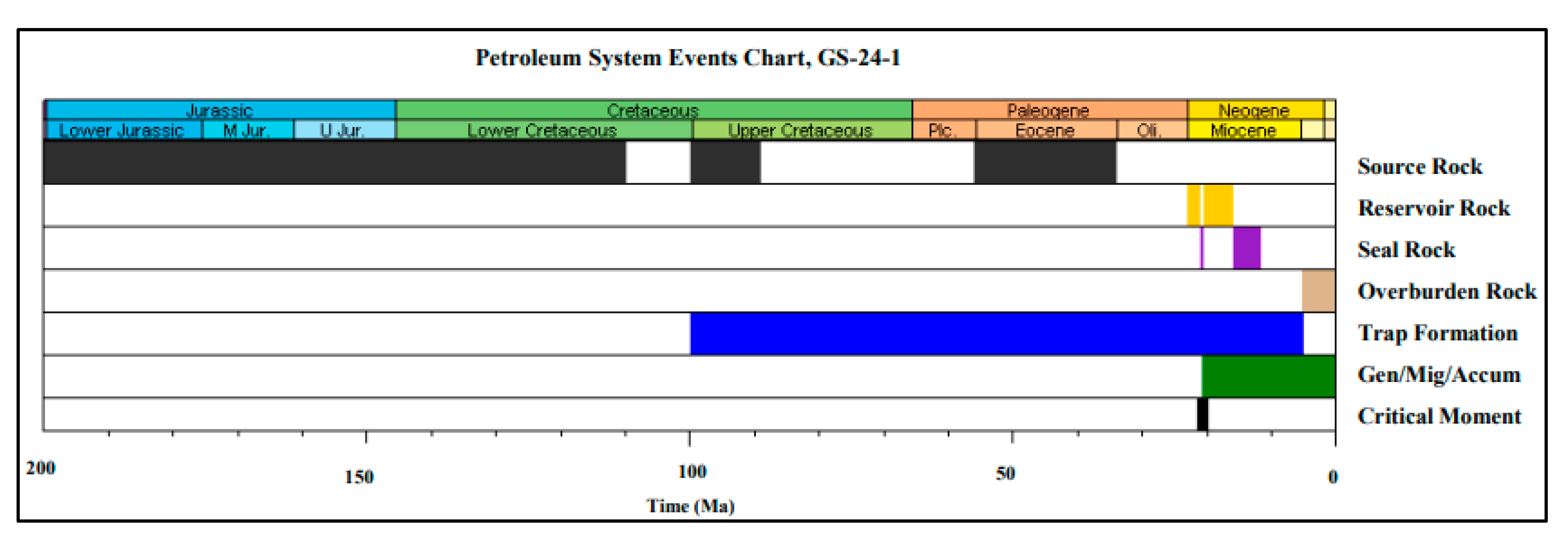
| Formation | No. | Value | TOC (wt%) | S2 (mg HC/g Rock) | Tmax (°C) | S2/S3 | HI (mg HC/g TOC) | OI (mg CO2/g TOC) | S3 (mg CO2/g Rock) | S1 (mg HC/g Rock) | PI |
|---|---|---|---|---|---|---|---|---|---|---|---|
| Thebes Fm. | 2 | Max. | 4.23 | 27.14 | 431.00 | 21.20 | 641.61 | 345.45 | 1.90 | 1.02 | 0.11 |
| Min. | 0.55 | 0.86 | 430.00 | 0.45 | 156.36 | 30.26 | 1.28 | 0.11 | 0.04 | ||
| Ave. | 2.39 | 14.00 | 430.50 | 10.83 | 398.99 | 187.86 | 1.59 | 0.56 | 0.07 | ||
| Matulla Fm. | 9 | Max. | 3.46 | 18.75 | 433.00 | 12.15 | 665.33 | 350.00 | 1.96 | 0.93 | 0.17 |
| Min. | 0.52 | 0.48 | 429.00 | 0.30 | 84.21 | 50.00 | 1.30 | 0.10 | 0.04 | ||
| Ave. | 1.36 | 6.53 | 430.67 | 4.18 | 353.65 | 187.11 | 1.60 | 0.36 | 0.10 | ||
| Raha Fm. | 18 | Max. | 9.60 | 60.31 | 434.00 | 23.20 | 709.41 | 292.54 | 3.22 | 4.92 | 0.11 |
| Min. | 0.67 | 1.67 | 427.00 | 0.91 | 222.67 | 27.08 | 1.66 | 0.19 | 0.04 | ||
| Ave. | 2.68 | 15.64 | 430.72 | 6.82 | 492.32 | 134.29 | 2.25 | 1.09 | 0.07 | ||
| St. dev. | 2.20 | 15.27 | 2.05 | 6.42 | 174.65 | 84.62 | 0.40 | 1.24 | 0.02 | ||
| Nubia-A (Upper) | 4 | Max. | 5.47 | 39.75 | 427.00 | 11.76 | 741.18 | 103.21 | 4.50 | 3.43 | 0.09 |
| Min. | 2.38 | 17.64 | 424.00 | 5.33 | 549.77 | 61.79 | 2.17 | 1.42 | 0.06 | ||
| Ave. | 3.87 | 25.16 | 426.25 | 8.01 | 651.21 | 85.61 | 3.22 | 2.09 | 0.08 | ||
| Nubia-A (Lower) | 36 | Max. | 5.41 | 39.92 | 436.00 | 17.80 | 753.04 | 282.98 | 4.29 | 4.09 | 0.17 |
| Min. | 0.91 | 3.10 | 424.00 | 1.19 | 203.62 | 42.31 | 1.92 | 0.41 | 0.05 | ||
| Ave. | 2.36 | 11.40 | 430.25 | 4.62 | 415.11 | 147.19 | 2.60 | 1.11 | 0.10 | ||
| St. dev. | 1.45 | 11.43 | 3.0 | 5.02 | 156.81 | 69.69 | 0.45 | 1.01 | 0.03 |
| Formation | MD Ft. | Number Ro% Measur. | St. Dev. | Min. Ro% | Max. Ro% | Ave. Ro% |
|---|---|---|---|---|---|---|
| Kareem Fm. | 2550 | 50 | 0.052 | 0.41 | 0.58 | 0.54 |
| Upper Rudeis Fm. | 3000 | 50 | 0.049 | 0.39 | 0.57 | 0.55 |
| Lower Rudeis Fm. | 3500 | 49 | 0.055 | 0.42 | 0.59 | 0.56 |
| Nukhul Fm. | 4950 | 50 | 0.061 | 0.55 | 0.66 | 0.64 |
| Matulla Fm. | 5450 | 50 | 0.074 | 0.49 | 0.67 | 0.65 |
| Raha Fm. | 5950 | 50 | 0.059 | 0.52 | 0.71 | 0.67 |
| Nubia-A (Upper) | 7250 | 50 | 0.066 | 0.48 | 0.67 | 0.65 |
| Nubia-A (Lower) | 8250 | 50 | 0.076 | 0.59 | 0.70 | 0.68 |
| 9050 | 50 | 0.063 | 0.61 | 0.77 | 0.73 | |
| 9400 | 60 | 0.090 | 0.63 | 0.80 | 0.77 |
| Formation | Age | Ma | MD (Ft.) | Thickness (Ft.) | ||
|---|---|---|---|---|---|---|
| From | To | Top | Bottom | |||
| Zaafarana | Post Miocene–Recent | 5.3 | 0 | 202 | 1800 | 1598 |
| Upper Miocene is absent (Unconformity) | 11.6 | 5.3 | 400 | |||
| Kareem Fm. | Middle Miocene | 15.9 | 11.6 | 1800 | 2800 | 1000 |
| Upper Rudeis Fm. | Early Miocene | 20.44 | 15.9 | 2800 | 3260 | 460 |
| Lower Rudeis Fm. | Early Miocene | 21 | 20.44 | 3260 | 4690 | 1430 |
| Nukhul Fm. | Early Miocene | 23 | 21 | 4690 | 5240 | 550 |
| Abu Zenima (Oligocene) is absent (Unconformity) | 33.9 | 23 | 1580 | |||
| Thebes Fm. | Eocene | 56 | 33.9 | 5240 | 5440 | 200 |
| Paleocene is absent (Unconformity) | 66 | 56 | 100 | |||
| Matulla Fm. | Late Cenomanian–Turonian | 95 | 66 | 5440 | 5850 | 410 |
| Raha Fm. | Cenomanian | 100 | 95 | 5850 | 7070 | 1220 |
| Nubia-A (Upper) | Early Cretaceous | 145 | 100 | 7070 | 7270 | 200 |
| Nubia-A (Lower) | Late Triassic–Late Jurassic | 237 | 145 | 7270 | 9400 | 2130 |
| Early Triassic is absent (Unconformity) | 237 | 252 | 1200 | |||
| Nubia-B | Carboniferous–Permian | 358 | 252 | 9400 | 9405 | 5 |
| Early Oil Generation (Ma) | Depth of Early Oil Window (ft.) | Main Oil Generation (Ma) | Depth of Main Oil Window (ft) |
|---|---|---|---|
| 132 | 4000 | 22 | 7400 |
Disclaimer/Publisher’s Note: The statements, opinions and data contained in all publications are solely those of the individual author(s) and contributor(s) and not of MDPI and/or the editor(s). MDPI and/or the editor(s) disclaim responsibility for any injury to people or property resulting from any ideas, methods, instructions or products referred to in the content. |
© 2024 by the authors. Licensee MDPI, Basel, Switzerland. This article is an open access article distributed under the terms and conditions of the Creative Commons Attribution (CC BY) license (https://creativecommons.org/licenses/by/4.0/).
Share and Cite
Farouk, S.; Fagelnour, M.; Zaky, A.S.; Arafat, M.; Salama, A.; Al-Kahtany, K.; Gentzis, T.; Jovane, L. Petroleum System Evaluation: Hydrocarbon Potential and Basin Dynamics in Abu Darag Sub-Basin, Northern Gulf of Suez (Egypt). Minerals 2024, 14, 1154. https://doi.org/10.3390/min14111154
Farouk S, Fagelnour M, Zaky AS, Arafat M, Salama A, Al-Kahtany K, Gentzis T, Jovane L. Petroleum System Evaluation: Hydrocarbon Potential and Basin Dynamics in Abu Darag Sub-Basin, Northern Gulf of Suez (Egypt). Minerals. 2024; 14(11):1154. https://doi.org/10.3390/min14111154
Chicago/Turabian StyleFarouk, Sherif, Mohamed Fagelnour, Amr S. Zaky, Mohamed Arafat, Ahmad Salama, Khaled Al-Kahtany, Thomas Gentzis, and Luigi Jovane. 2024. "Petroleum System Evaluation: Hydrocarbon Potential and Basin Dynamics in Abu Darag Sub-Basin, Northern Gulf of Suez (Egypt)" Minerals 14, no. 11: 1154. https://doi.org/10.3390/min14111154
APA StyleFarouk, S., Fagelnour, M., Zaky, A. S., Arafat, M., Salama, A., Al-Kahtany, K., Gentzis, T., & Jovane, L. (2024). Petroleum System Evaluation: Hydrocarbon Potential and Basin Dynamics in Abu Darag Sub-Basin, Northern Gulf of Suez (Egypt). Minerals, 14(11), 1154. https://doi.org/10.3390/min14111154












